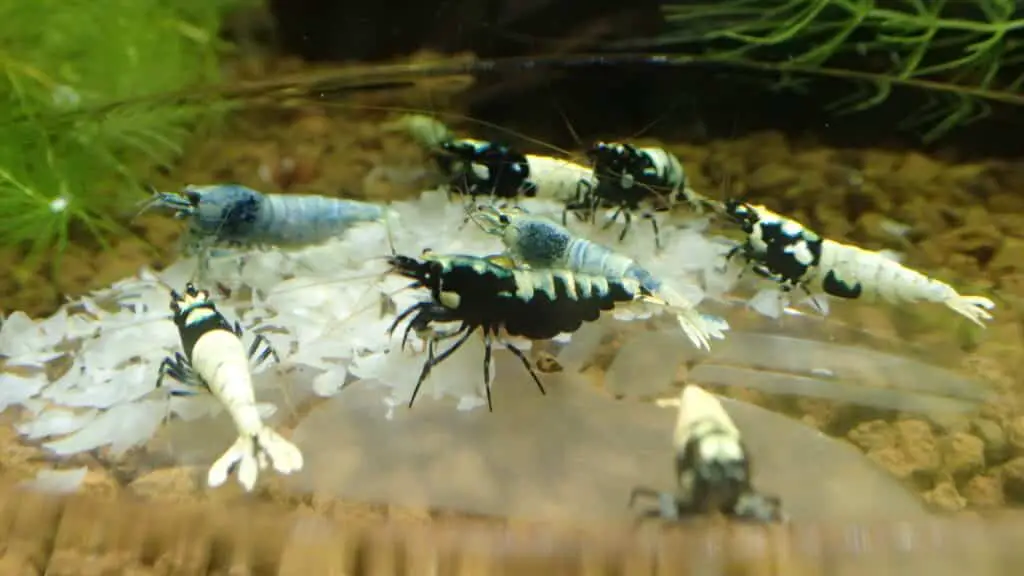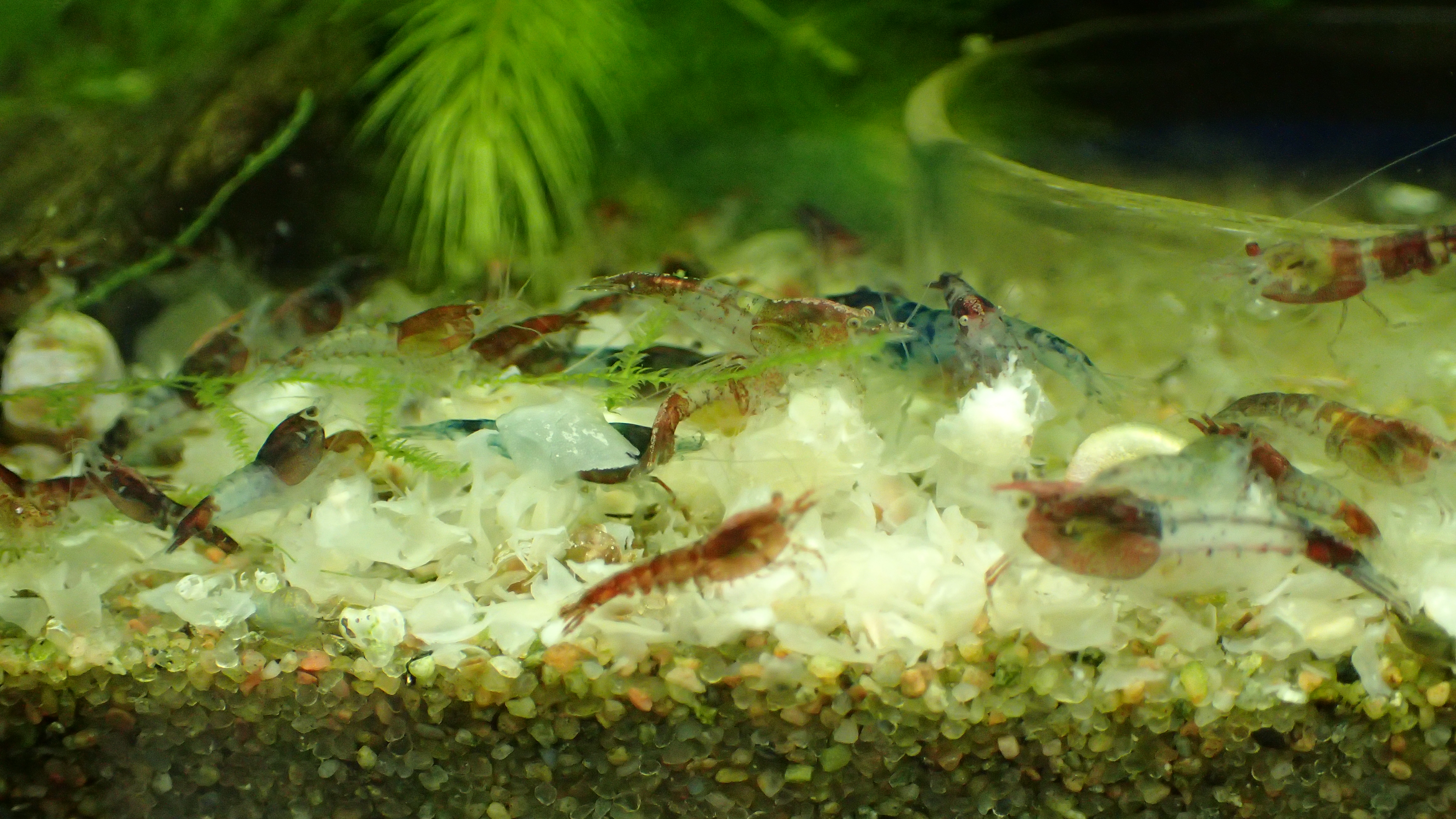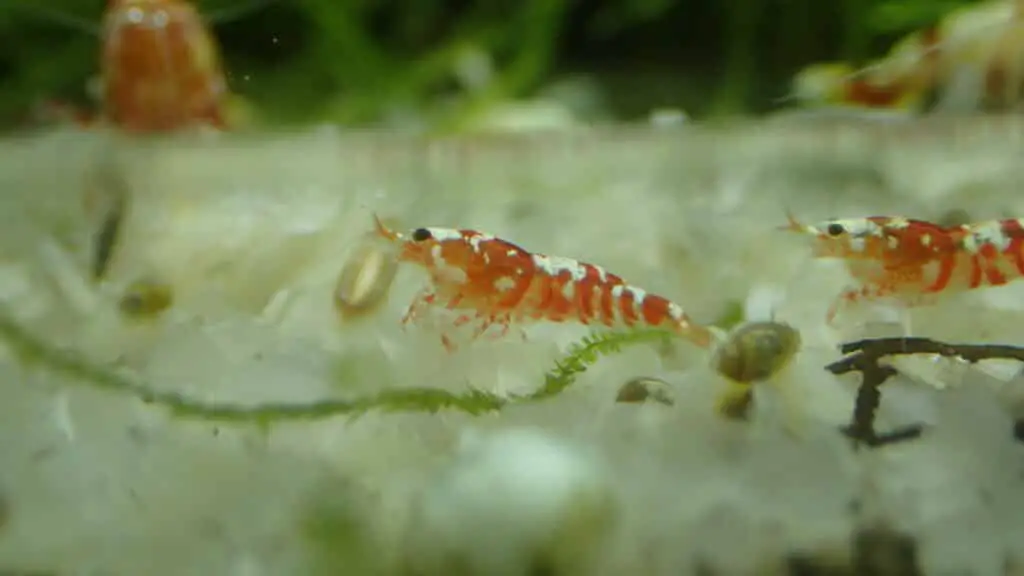A balanced and nutritious diet is crucial for the overall health of the shrimp. It promotes their growth, boosts their immune system, enhances their color, and even influences their reproduction. An inadequate or unbalanced diet, on the other hand, can lead to various health problems, slow growth, and a decrease in overall vitality.
One particular type of food that has gained favor among shrimp enthusiasts is known as “snowflake shrimp food.” This food, despite its seemingly whimsical name, plays a serious role in the dietary regime of shrimp. Contrary to what the name might suggest, snowflake shrimp food doesn’t have anything to do with snow or winter but is derived from a much more common and somewhat unexpected source: soybean hulls.
Snowflake shrimp food, with its unique composition and slow breakdown rate, offers an excellent food source for shrimp, providing them with the opportunity to exhibit their natural grazing behavior. It is a special addition to a shrimp’s diet, one that not only meets their nutritional needs but also contributes positively to their habitat. In the forthcoming sections, we will explore snowflake shrimp food in more detail, delving into its origins, benefits, and how it could be a game-changer in your shrimp-keeping journey.

What is Snowflake Shrimp Food?
Snowflake shrimp food, as mentioned earlier, is a unique type of food primarily composed of soybean hulls, the outer coating of soybean seeds. Soybean hulls are a by-product of the soybean industry, where they are typically removed during the process of making soybean meal or oil. Yet, these seemingly ordinary hulls harbor extraordinary benefits for shrimp, earning them a prominent place in the world of shrimp keeping.
The soybean hulls in snowflake shrimp food offer a rich source of dietary fiber, a component that is not only nutritious for shrimp but also provides an excellent substrate for biofilm growth. Biofilm, a layer of microorganisms including bacteria and algae, is a natural part of aquatic ecosystems and a favorite grazing material for shrimp. It’s rich in various nutrients and provides a buffet of diverse food options for the shrimp, encouraging their natural foraging behaviors.
One of the standout features of snowflake shrimp food is its slow breakdown rate in water. Unlike some other types of food that can disintegrate quickly, snowflake food maintains its structure over a longer period. This feature is beneficial in two significant ways. Firstly, it allows the shrimp to graze on it over several days, imitating their natural feeding habits in the wild. Secondly, it prevents the food from fouling the water too quickly, maintaining the water quality and overall cleanliness of the tank.
These soybean hulls not only feed the shrimp directly but also promote the growth of additional food sources, creating a dynamic and thriving microecosystem within the tank. This unique characteristic of snowflake shrimp food enhances the overall shrimp keeping experience, bringing us closer to understanding and replicating the natural environments in which these fascinating creatures thrive.

The Additional Benefit: Mycelium Growth
The benefits of snowflake shrimp food extend beyond the soybean hulls themselves. There’s an additional, fascinating aspect to this type of food that sets it apart from other shrimp diets. This extra benefit comes in the form of mycelium, the vegetative part of a fungus.
Mycelium consists of a network of thread-like structures known as hyphae. Like the roots of a plant, mycelium reaches out into the environment around it, breaking down and absorbing nutrients from organic matter. In the case of snowflake shrimp food, the organic matter is the soybean hulls. As the mycelium grows and spreads, it starts to break down the soybean hulls, creating a biofilm layer that’s rich in nutrients and ideal for shrimp to graze on.
The presence of mycelium can potentially enhance the overall health of the tank environment. By breaking down organic matter, mycelium helps recycle nutrients within the tank, indirectly contributing to maintaining water quality. It also adds to the biodiversity of the tank, creating a more complex and enriching environment for the shrimp.
However, it’s essential to keep in mind that the introduction of mycelium into a shrimp tank isn’t without potential risks. Certain types of fungi can be pathogenic to shrimp, causing diseases that could harm or even kill your shrimp. Furthermore, a rapid or overgrowth of fungi could potentially disrupt the balance of the tank, leading to water quality issues.
Therefore, while the growth of mycelium on snowflake shrimp food can provide numerous benefits, it’s crucial to approach this aspect with caution. Close monitoring of your shrimp and regular checks on water parameters should be part of your routine. If you notice any unusual behavior from your shrimp or changes in the water quality, it might be necessary to remove the food and consult with a shrimp keeping expert.
In the world of shrimp keeping, the key to success lies in balance. The introduction of mycelium through snowflake shrimp food could be a wonderful way to enhance your shrimp’s environment and diet, as long as it is managed carefully and responsibly.

Making Homemade Snowflake Shrimp Food
For those shrimp keepers who enjoy a more hands-on approach, creating homemade snowflake shrimp food can be a rewarding and cost-effective endeavor. This process involves leveraging the nutritious value of soybeans and transforming them into a shrimp-friendly food source. Here’s how you can do it:
Start by choosing high-quality, unprocessed soybeans. Soak the soybeans in water overnight. This softens the outer hulls and prepares them for the next step. The following day, you’ll need to pop the beans out of their softened shells. This process can be a bit time-consuming, but it’s a crucial step, as the hulls are the main ingredient in snowflake shrimp food.
Once you’ve separated the hulls from the beans, the next step is drying them. A dehydrator works best for this purpose, as it can thoroughly dry the hulls without cooking them. Spread the hulls out in a single layer in the dehydrator and allow them to dry until they’re completely moisture-free. Once dried, the hulls can be stored for future use.
While making homemade snowflake shrimp food can be a fun and rewarding process, it’s essential to keep in mind some potential differences between homemade and commercially available products. Commercial snowflake shrimp food often undergoes specific processes to ensure consistency, nutritional value, and safety. For instance, they might use heat treatment to kill potential pathogens. Additionally, commercial products may also contain other ingredients to provide a more balanced nutrient profile.
On the other hand, homemade snowflake shrimp food allows for control over the ingredients used and can be a more natural and unprocessed option. However, it’s important to monitor your shrimp closely when introducing any new food into their diet.
Remember, the goal is to provide a balanced and nutritious diet for your shrimp, whether you’re using homemade or commercial food. By understanding the needs of your shrimp and being attentive to their responses, you can create a thriving environment for them to enjoy.

Feeding Your Shrimp Snowflake Food Tips
Feeding your shrimp snowflake food involves a few simple steps. First, you’ll want to add a small piece of the food to your shrimp tank. Remember, the unique aspect of snowflake food is that it doesn’t break down quickly, so it’s okay if it appears that your shrimp aren’t immediately swarming towards it. They typically graze slowly and continuously, just as they would in their natural habitats.
As the snowflake food begins to break down in the water, it will start to grow a biofilm and possibly mycelium. These growths provide additional food sources for your shrimp, enriching their diet and promoting their natural foraging behaviors. Over a few days, you’ll likely see your shrimp repeatedly visiting the snowflake food, picking at it, and enjoying the bounty it offers.
One of the great benefits of snowflake shrimp food is that it can be left in the tank for several days without significantly affecting the water quality. This characteristic makes it a convenient food option, especially if you need to leave your shrimp unattended for a few days. However, it’s important to observe your shrimp and adjust the amount of food given based on their needs. If you find leftover food even after a few days, it’s a sign you may be overfeeding and should reduce the quantity in future feedings.
While snowflake shrimp food can be a fantastic addition to your shrimp’s diet, it’s important to remember that it should not be the only food source for your shrimp. A balanced diet for shrimp often includes a variety of foods to meet their different nutritional needs. This can include other types of prepared shrimp food, blanched vegetables, and occasional protein sources. Snowflake shrimp food fits into this dietary regime by providing fiber and promoting biofilm growth, but other nutrients must be supplied through diverse food sources.
Understanding the dietary needs of your shrimp and providing a balanced and varied diet, you can ensure that your shrimp not only survive but thrive. Snowflake shrimp food, with its unique properties and benefits, can play a vital role in this dietary balance, contributing to the health and happiness of your shrimp.

Conclusion
Snowflake shrimp food represents a unique and beneficial addition to the dietary regime of shrimp. Derived from soybean hulls, this food not only provides a nutritious meal for the shrimp but also promotes the growth of biofilm and potentially mycelium, enhancing the overall environment within the tank. Its slow breakdown rate aligns well with the natural grazing habits of shrimp and helps in maintaining water quality.
Creating homemade snowflake shrimp food can be a rewarding process for shrimp keepers, offering control over ingredients and a more natural option. However, it’s crucial to ensure that the food is safe and suitable for your shrimp and that it fits into a balanced and varied diet.
Whether you are new to shrimp keeping or an experienced hobbyist, snowflake shrimp food could be a worthy consideration for your shrimp’s diet. Its unique characteristics and benefits can contribute positively to your shrimp’s health and the overall vibrancy of your tank. However, as with any aspect of shrimp keeping, careful observation, regular monitoring, and a cautious approach are key to maintaining a healthy and thriving shrimp population.
Shrimp keeping is a journey of discovery and learning, with each decision bringing us closer to understanding these fascinating creatures. The use of snowflake shrimp food is one such decision – a step towards a more natural and enriching diet for your shrimp.
Happy Shrimp Keeping!!

(FAQ) section about shrimp feeding
Q1: How often should I feed my shrimp?
A1: Shrimp can be fed once or twice a day, depending on their size and the size of the shrimp colony. However, shrimp are also excellent scavengers and will continuously graze on algae and biofilm in the tank. Make sure to remove any uneaten food after a few hours to prevent water quality problems.
Q2: Can I overfeed my shrimp?
A2: Yes, overfeeding shrimp can lead to poor water quality, as uneaten food will decompose and produce harmful substances like ammonia. It’s better to underfeed than overfeed; shrimp can survive for quite some time without food as they can consume algae and biofilm in the tank.
Q3: What are the signs of underfeeding or overfeeding?
A3: Signs of overfeeding include poor water quality, increased algae growth, and uneaten food. Underfeeding can lead to slow growth, poor coloration, and increased aggression as shrimp compete for food.
Q4: Can shrimp eat fish food ?
?
A4: Shrimp can eat fish food, and it can be a part of their diet. However, it shouldn’t be the only food source as it might not provide all the necessary nutrients shrimp need. A varied diet that includes specially prepared shrimp food, vegetables, and occasional protein sources is best.
Q5: How does snowflake shrimp food fit into my shrimp’s diet?
A5: Snowflake shrimp food is a great addition to a shrimp’s diet. It provides dietary fiber, promotes biofilm growth, and can remain in the tank for several days without polluting the water. However, it should not be the only food source for your shrimp. A balanced diet for shrimp should include a variety of foods.
Q6: Can I make my own shrimp food?
A6: Yes, you can make your own shrimp food like snowflake shrimp food using soybean hulls. However, it’s essential to ensure that the food is safe and suitable for your shrimp. Also, homemade food should fit into a balanced and varied diet for your shrimp.
Q7: What do I do if my shrimp aren’t eating the food I give them?
A7: If your shrimp aren’t eating, it could be due to several reasons including poor water quality, stress, or illness. It could also be that they simply don’t like the food. Try offering a variety of foods to see if they have a preference. If they still aren’t eating and you notice other signs of stress or illness, you should consult a shrimp keeping expert or veterinarian.
Remember, these are general answers and the specifics might vary based on the species of shrimp, their size, and the conditions within your particular aquarium. Always observe your shrimp closely and adjust their care based on their behavior and health.
